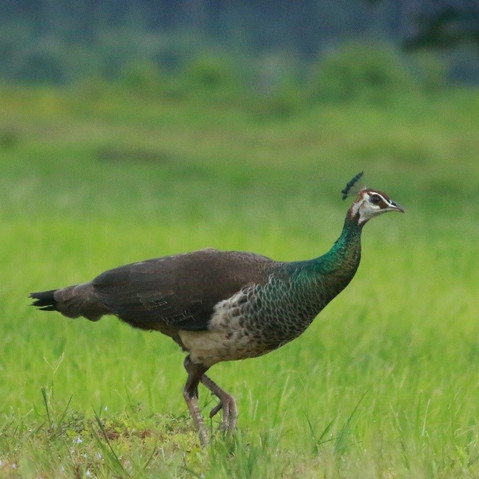... or Bilateral Gynandromorphism and Chimerism
When you look in the mirror, you know what sex you were born with. This is down to the genetics that were given to you by your parents. But that genetic sex isn’t where it stops, the world is full of examples of genetic codes gone a little…strange.
The first stop on this discussion of genetics might be one of the most impressive. When you look at yourself you see the same proportions on either side, this is called "facial symmetry". Regardless of the fact that your face isn’t ENTIRELY symmetrical, you’re still male or female on both sides of your face (and body). On a quick side note, Time.com has a FASCINATING article about facial symmetry and how we’re not 100% symmetrical... (HIGHLY recommend it when you’re done here, of course). But when genetics go a little haywire, strange and beautiful things can happen.
Our next stop on this genetic train of discussion is when the male and female of species look different. This is called “sexual dimorphism”. Not sure if you’ve seen or heard about this before? Think to the beautiful plumage of a peacock and the dull and drab colors of the peahen. Evolutionarily speaking, this happens because the peahen needs to blend into its environment when it is nesting (on the ground), and her drab coloring helps her do just that. The peacock has the ostentatious feathers to get the attention of the females to help show off his...prowess. This is only one of many examples of sexual dimorphism in the world. Mandarin ducks, elephant seals, black widow spiders and humans all exhibit this dimorphism. Heck, some flowering plants have different flowers to help their insect pollinators!
Peacock and Peahen. Courtesy of Wikimedia Commons
We move now to something much more interesting. Scientifically called “bilateral gynandromorphism” or a Gynandromorph (gyn·an·dro·morph) is when an organism exhibits morphological characteristics of both sexes, meaning it has the outward appearance of being both male and female...Weird, right? Keep reading!
Occasionally in the early development of an embryo, when the organism contains only a few cells, one of those cells does not split the sex chromosomes normally. This occasionally leads to half of the cells of that organism being female and half male. This continues as the development continues until birth, or hatching. While the gynandromorph will often survive, it can occasionally be cast out as a member of the species; as in the case of this Northern Cardinal, first spotted by a retired high-school teacher named Robert Motz of Illinois.

Note that half of this bird is the bright red typical of the male and the other half, the dull tan of the female cardinal. Eventually, Robert’s observation made its way to the attention of ornithologist Dr.Brian Peer at Western Illinois University. In an interview with Professor Peer he was quoted as saying "It was an incredibly fascinating and striking individual. If you could only see one side, you would think it was male or female. It was an almost perfect split." According to Dr. Peer, this cardinal never make an attempt to sing a song. "Whether it was even capable of vocalizing, we just don't know.”[1] Because of this genetic mix-up, gynandromorphs are often infertile, like mules. And it’s not only birds that display this gynandromorphism, lobsters and insects have been documented displaying their unique set of genetics. Currently there are no known examples of human Gynandromorphism.
Gynandromorphic lobster and moth. Courtesy Wikimedia Commons

A more recent and popular display of genetics run amok can be seen in Venus, the Two-Faced cat. A calico cat with a striking face, who’s owner boasts her cat is “0% Photoshopped, 100% Born This Way!” What makes her so special is not gynandromorphism, but rather her calico (genetic) pattern gone crazy! Columbia University Professor of Genetics and Development, Dr. Virginia Papaioannou explains that she is not a chimera (which we’ll get into in a bit), rather, “It’s a striking example of a calico cat. It’s a fairly straightforward example of X-inactivation mosaicism, with the addition of a white spotting gene.”[2] More on Venus can be found at Smithsonian Magazine’s 2012 article on her. Personally, having had a calico cat growing up, I can attest to their striking appearance such as Venus here, although my beloved cat had only splotches of color across her body (that actually grew and changed during her life), nowhere near Venus' impressive coloration or stunning eyes.
So, if Venus is not a chimera, what is she and what is a chimera?
Spoiler Alert: Venus is just your average house cat with an extraordinary color pattern!
So... What is a chimera?
A chimera can refer to the mythical creature, usually depicted as a lion, with the head of a goat protruding from its back, and a tail that might end with a snake's head. Genetically speaking, and according to Scientific American, “A chimera is essentially a single organism that's made up of cells from two or more ‘individuals’—that is, it contains two sets of DNA, with the code to make two separate organisms.” Chimeras are naturally occurring and in the case of human chimeras, happen in utero; typically associated with fraternal twins. When they are very, very, VERY young, one of the twins dies and is naturally “absorbed” by the surviving fetus. The surviving fetus will now have two sets of cells, the one it was made from, plus the set that it got from its twin.

Meet singer Taylor Muhl, a woman who is genetically her own twin. Her chimerism (ki-MER-ism) is the reason for the large (pink) birthmark you on her left side. The reason behind the different pigment of her skin is the result of the twin she absorbed while in utero. When not performing, Taylor is an advocate for chimerism, but she is not the only human chimera of note. A woman named Karen Keegan wound up in a strange situation when DNA tests confirmed she wasn't the biological mother of her own children! It turned out that the DNA in her blood was different than the DNA in her ovaries (and eggs). Doctors said her extra DNA most likely came from a long-gone fraternal twin — and in 2002 her story became a report in the New England Journal of Medicine! According to the American Pregnancy Association, estimates indicate that vanishing twin syndrome occurs in 21-30% of multifetal pregnancies. This means that many of these surviving twins could be a chimera and not even know it! Genetic testing is the only way to confirm if this is true, as in the case of a man from Washington state who took a cheek-swab paternity test that confirmed he was technically his son's uncle, not his father! Besides occurring naturally such as in utero, chimerism can result from bone marrow donations. This exceedingly rare situation includes a situation where a man from Nevada received a bone marrow transplant from a man in Germany. The man from Nevada went on to eventually completely lose all of his original DNA and was now genetically identical to the German man (this took place over the course of four years)! [3]
There are other non-human cases of this fascinating genetic mutation such as the African Violet Plants or roses such as the one below. A little research on your part will show you Gynandromorphism like the blue and orange lobster (above), the chicken with male and female parts, butterflies split down the middle (similar to the moth above), spiders and peacocks. Your new knowledge about chimerism might lead you to seek the genetic truth about the birthmark you've always wondered about.

You might have blue eyes, red hair, be taller than every family member, gifted with a fantastic memory, maybe you have a situation like chimerism and carry the genetics from a sibling you never knew you had. If you want even more reading, please check out Natural History Magazine’s article about Gynandromorphism or the other links throughout this post. And if that’s not enough for you and you want to read the New England Journal of Medicine’s report on Karen Keegan please do so, it’s free and FASCINATING!! Just remember it’s written academically and might be somewhat difficult to understand everything, especially to those of us, like myself, who haven’t been educated to that level.
Until next time, keep wondering about the world, you never know where your curiosity might take you.
[1] www.bbc.com/earth/story/20150916-these-animals-are-male-on-one-side-and-female-on-the-other [2] https://newrepublic.com/article/118725/venus-chimera-cat-explained-geneticist [3] www.independent.co.uk/news/world/americas/dna-bone-marrow-transplant-man-chimera-chris-long-forensic-science-police-a9238636.html










Nature is magical! Thank you for sharing such a wonderful story with us! geometry dash wave